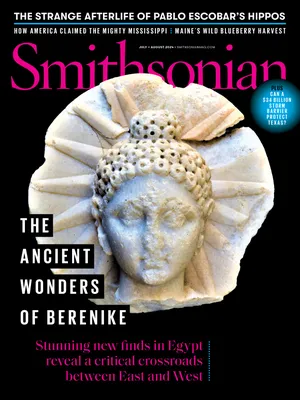How a Questionably Fashionable Shirt Bowled America Over
The gaudy top went from practical necessity to vintage treasure
:focal(1078x698:1079x699)/https://tf-cmsv2-smithsonianmag-media.s3.amazonaws.com/filer_public/53/11/5311716f-c336-4690-bc3a-28942f61af6b/gettyimages-bldcb0412cda_0240.jpg)
The new Skipper bowling shirt of 1940 offered a sports-friendly fit and boasted that it was “pre-tested by actual bowlers.” Readers today would be surprised by ads for the Skipper, in which a model wears the shirt with a necktie and appears to be buttoning the cuffs of his long sleeves. At the time, this decorous attire was standard at bowling alleys, where women often wore dresses or skirts.
But over the next decade, sprawling suburban developments and innovative automatic pin-setting machines inspired a boom in family-friendly bowling centers: Between 1945 and 1957, at least 20,000 new lanes cropped up across the country, some in new establishments sporting flashy chrome, bright upholstery, swanky lounges and other hallmarks of midcentury design. By 1958, the American Planning Association declared that the bowling alley was fast becoming an important hub for recreation; in some suburbs, it was called “the poor man’s country club.”
The massive uptick in popularity—membership in the American Bowling Congress tripled between 1940 and 1958—and the dominance of league tournaments (some lanes even offered child care so women could compete during the day) led to a demand for shirts that were both comfortable as athletic wear and distinctive as uniforms.
During this boom, clothing makers offered roomier shirts with shorter sleeves, longer tails to stay tucked in and softer collars meant to be worn without a tie. They were often made of soft rayon or gabardine, with bright colors for easy team identification. All of these features coalesced into the now-classic bowling shirt, a casual, sporty garment that could move from the competitive lanes to the relaxing atmosphere of the lounge.
Not every shirt with a camp collar, short sleeves and button front was meant for bowling, but the name stuck as the shirt entered the regular rotation of casualwear.
Of course, serious bowlers likely replaced their uniforms regularly to accommodate new team names and sponsors. “Would it be an exaggeration to claim that half the men and a healthy percentage of the women of the Buffalo area have closets stuffed with old bowling shirts?” a writer in the Buffalo News asked in 1982. That same decade, league bowling fell out of style for younger and more casual players—but retro fashions caught on. With teens chasing vintage looks, these classic shirts became a symbol of alternative, sometimes kitschy, cool. Soon, the bowling shirt was like tennis shoes or baseball caps—fashion with a cultural cachet independent of its sporty origins.
Today, vintage bowling shirts can be haute couture—or simple, nostalgic treasures. But they aren’t uniforms anymore. The pros long ago switched to zip-up jerseys, or sometimes shirts with a different sporty name: polos.
